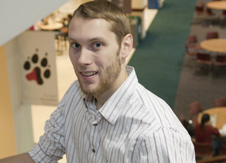The journey from idea to reality

While on co-op at a global engineering firm, Northeastern University junior Brian Racca was confronted with a vexing challenge of redesigning a small, but critical component of a nuclear reactor valve.
“There were so many different design configurations I went through. I can’t say how many pieces of paper that I went through. There were piles of them,” said Racca, who ultimately produced a custom design that suited the needs of the U.K.-based company, The Weir Group PLC.
The task not only tested Racca’s ability to understand the valve’s intricate design, but it forced him to think about why the part needed to be replaced — the type of larger question engineers face every day in the real world. As a result, he gained valuable experience addressing engineering challenges in ways he’d never done before.
“There is always more than one way to look at an engineering problem,” Racca said. “Whenever I approached someone at Weir with a question, they’d always answer it with another question. It definitely helped me learn as much as I did.”
Racca, a mechanical engineering major, spent six months on co-op last year working at Weir. He tackled numerous engineering design projects that came across his desk, helping the company improve engineering solutions, often under pressure and tight deadlines. The branch where Racca was located in Ipswich, Mass., produces valves used for a range of applications in power plants, nuclear plants and other commercial facilities. The company’s valves are manufactured and used in plants throughout the world.
One of his assignments involved studying a nuclear power plant valve that carries river water but was collecting too much dirt and sediment. He fixed the problem by simulating tests to discover how to reduce the amount of friction inside the valve.
For another assignment, Racca assessed the best properties of two similar valve designs and worked to integrate them into one new design to improve efficiency and lower costs. A third task involved calculating the maximum amount of stress different valves could handle on the job.
Racca said his hands-on experience at Weir would pay huge dividends in the future, particularly because of the critical-thinking skills he developed there.
“One of the biggest things I wanted to take out of this co-op was the design experience — how you go about designing a part, and how you make it a reality,” he said.




